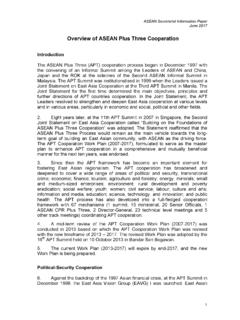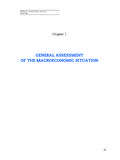Transcription of A Guide to Preparing the Economic Development …
1 A Guide to Preparingthe Economic Development Elementof a comprehensive PlanWisconsin Economic Development Institute, , 20031 Table of ContentsForeword .. 2 Acknowledgments .. 3 Chapter 1 - Wisconsin s comprehensive Planning Law .. 4 The law and its requirements for local communitiesChapter 2 - The Need for Economic Development .. 6 Understanding the law s Economic Development elementChapter 3 - Planning for Economic Development .. 8 The basics of successful community-based Economic developmentChapter 4 - Organizational Development .. 16 Taking charge of Economic Development in your communityChapter 5 - Infrastructure .. 21 Establishing the physical foundation for Economic developmentChapter 6 - Business Development .
2 24 Retention and expansion, attraction and entrepreneurshipChapter 7 - Workforce Development .. 32 Education, training and skill developmentChapter 8 - Community Cash Flow .. 35 Bringing new dollars into a communityChapter 9 - Regional Collaboration .. 41 Increasing capacity by working togetherReferences and Resources .. 44 Glossary .. 45 Appendices .. 47 Community Economic Development Checklist .. 47 Twenty Questions about Your Community .. 53 Business Development Resources .. 542 ForewordCommonly known as Wisconsin s Smart Growth Law, significant changes toplanning-related statutes were approved in Wisconsin s 1999-2001 state law describes the framework for developing comprehensive plans; a grantprogram, which will provide communities an incentive to begin efforts early, and aconnection to other planning-related actions to provide overall consistency with theplan developed by the local community.
3 The Wisconsin Land Council is responsiblefor administering the comprehensive planning effective date of the recodification of Chapter 66, Wisconsin Statutes wasJanuary 1, 2001. By January 1, 2010, all communities that make land usedecisions will need to base those decisions on an adopted comprehensiveplan derived from the new statutory statute specifies nine required elements in each comprehensive plan, as aminimum. One of the specified elements is Economic Development . The statute,however, does not provide detail for each element. Consequently, handbooks arebeing written and made available to Wisconsin communities to assist with developingprocedures for each completed handbooks are available at the Wisconsin Department ofAdministration Website: , as are filed copies of completedcommunity comprehensive plans.
4 Copyright 2003 Wisconsin Economic Development Institute (WEDI), East Doty Street, Suite 500 Madison, WI 53703-3397 Phone:608-661-4626 document is presented as a Guide for local Economic Development planning. The views and opinionsexpressed in this publication are those of the ad hoc Economic Development Element ComprehensivePlanning Committee authors (see next page) and not necessarily those of the reviewers or the fundingpartner Economic Development Institute, Inc. and its partners:Roger Nacker, Wisconsin Economic Development Institute, Alf, Forward WisconsinMary Cole-Laub, Alliant EnergySteven Deller, Department of Agriculture & Applied Economics, UW-MadisonKarna Hanna, Sauk County Development CorporationKelly Haverkampf, Wisconsin Rural Partners, Heady, Wisconsin Department of Commerce - Economic DevelopmentMarcia Theusch, Milwaukee Economic Development CorporationOther contributors and reviewers:Alan Anderson, UW-Extension Center for Community Economic DevelopmentTodd Barman, Wisconsin Department of Commerce - Main Street ProgramGary Becker, Vierbicher Associates, H.
5 Grabow, Associate Professor, UW-Extension Jefferson CountyCharyn Grandau, Wisconsin Office of Land Information ServicesTony Hozeny, Wisconsin Department of CommerceAndy Lewis, UW-Extension Center for Community Economic DevelopmentBrian W. Ohm, Department of Urban and Regional Planning, UW-Madison/ExtensionTed Penn, Wisconsin Public Service CorporationBill Ryan, UW-Extension Center for Community Economic DevelopmentEric Schmidtke, Wisconsin Office of Land Information ServicesRon Shaffer, Prof. Emeritus, Agriculture & Applied Economics, UW-Madsion/ExtensionWEDI Board of DirectorsFunding Partners:Alliant EnergyDairyland Power CooperativeWisconsin Department of CommerceWisconsin Economic Development AssociationWisconsin Public Service CorporationXcel EnergyEditing by Leah Call; Design by Kelly Haverkampf4 Chapter 1 Wisconsin s comprehensive Planning LawWisconsin s land-use planning law (commonly called the SmartGrowth Initiative) was passed as part of the 1999 biennial statebudget act.
6 It applies to all local government entities (cities,villages, towns, counties and regional planning commissions).The law defines comprehensive planning in Wisconsin for thefirst time. The comprehensive plan definition will provide localgovernmental units with a framework for making more informedland-use decisions. Land use planning actions do not happen in avacuum. The statute describes how local governmental units canbetter assess the impact of their decisions on all aspects of thecommunity, by requiring that the plan include the nine elementslisted in the box at left, thus making it comprehensive . One of therequired elements is Economic January 1, 2010, all incorporations, annexations, boundarychanges, plat approvals and zoning ordinances -- essentially allland use regulation -- must be consistent with the adoptedcomprehensive requirements of the law include: The plan is required to cover a 20-year period, including land-use projections for every five years.
7 The transportation and intergovernmental cooperationelements must address joint planning with regions and otherjurisdictions. Public utility and community facility growth and maintenanceare required to have approximate timetables. The plan must include a plan for evaluation and updating atleast every 10 years. The planning commission is prescribed, including arequirement for citizen members. Public hearings are required for adoption or required elements forcomprehensive planning underWisconsin s ComprehensivePlanning Law:1. Issues and Opportunities2. Housing3. Transportation4. Utilities and CommunityFacilities5. Agricultural, Natural andCultural Resources6. Economic Development7.
8 IntergovernmentalCooperation8. Land-Use9. ImplementationThe law and its requirements for local communities5In addition to the requirements for local governments, the Compre-hensive Planning Law sets forth fourteen goals of comprehensiveplanning which the Department of Administration is directed to givepreference to in providing comprehensive planning grants. Stateagencies are encouraged to balance their missions with these goals,and are also encouraged to design administrative rules to furtherreflect that balance. Communities seeking State funding should keepthese goals in mind as they undertake the comprehensive Promotion of the redevelopment of lands with existing infrastructure andpublic services and the maintenance and rehabilitation of existing resi-dential, commercial and industrial Encouragement of neighborhood designs that support a range of trans-portation Protection of natural areas, including wetlands, wildlife habitats, lakes,woodlands, open spaces and groundwater Protection of economically productive areas, including farmland Encouragement of land uses, densities and regulations that promoteefficient Development patterns and relatively low municipal.
9 State govern-mental and utility Preservation of cultural, historic and archaeological Encouragement of coordination and cooperation among nearby units Building of community identity by revitalizing main streets and enforcingdesign Providing an adequate supply of affordable housing for individuals of allincome levels throughout each Providing adequate infrastructure and public services and an adequatesupply of developable land to meet existing and future market demandfor residential, commercial and industrial Promoting the expansion or stabilization of the current Economic baseand the creation of a range of employment opportunities at the state,regional and local Balancing individual property rights with community interests and Planning and Development of land uses that create or preserve variedand unique urban and rural Providing an integrated, efficient and economical transportation systemthat affords mobility, convenience and safety and that meets the needs ofall citizens, including transit dependent and disabled on theComprehensive PlanningLaw:The Wisconsin Department ofAdministration (DOA)( ) throughits Office of Land InformationServices (OLIS) is the sourcefor.
10 Information on the compre-hensive planning statutes, a listor copy of comprehensive planswhich have been submitted, thelocation for obtaining copies ofcompleted Element Guides, and details on the state s grantprogram for local governmentsto produce Development comprehensive Planning recognizes theconnection between Economic Development and quality of life. Itleverages new growth and redevelopment to improve the are a variety of community Economic Development plans, butsuccessful communities tend to have one thing in common anarticulated, shared vision of where they want to go and of whatthings residents and businesses value in their community. Their plansfor Economic Development reflect these shared term Smart Growth lacks a universal definition.





